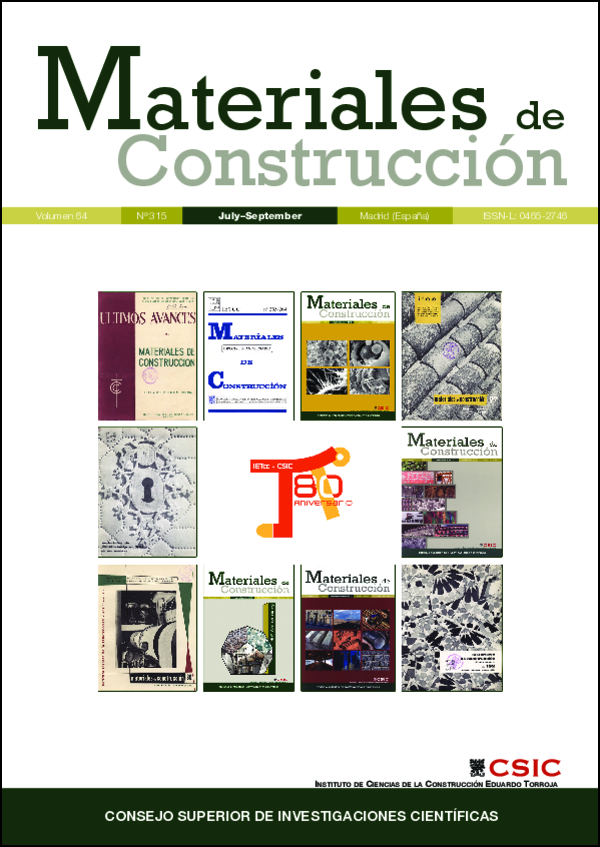Effect of the aggregate grading on the concrete air permeability
DOI:
https://doi.org/10.3989/mc.2014.07213Keywords:
Air Permeability, Aggregate grading, Concrete durabilityAbstract
Great durability problems are being found in concrete structures related to the penetrability of aggressive agents through the concrete (ie. chloride penetration, sulphate attack, carbonation, freezing and thawing, and so on). Air permeability coefficient is used as an effective tool to estimate the potential durability of concrete structures due to its direct relation with the microstructure and the moisture content. This paper discusses the effect of the aggregate grading and water/cement ratio on the air permeability coefficient. An aggregate grading with more sand than coarse aggregates has resulted more beneficial from the point of view of concrete air permeability. This fact can be attributed to a denser skeleton formed by the finer aggregates. With fine aggregates, the higher water/cement ratio, the lower air permeability. However, the contrary was found with coarse aggregates. Overall, a temperature increase from 20 °C to 60 °C during preconditioning led to a Dair increase of 40–80%.
Downloads
References
Hall, C. (1989) Water sorptivity of mortars and concretes: a review. Mag. Concr. Res. 41 [147], 51–61. http://dx.doi.org/10.1680/macr.1989.41.147.51
Pihlajavaara, S.E.; Paroll, H. (1975) On the Correlation between Permeability Properties and Strength of Concrete. Cem. Concr. Res. 5 [4], 321–328. http://dx.doi.org/10.1016/0008-8846(75)90088-5
Soongswang, P.; Tia, M.; Bloomquist, D. (1991) Factors affecting the strength and permeability of concrete made with porous limestone. ACI Mat. J. 88 [4], 400–406.
Samaha, H.R.; Hover, K.C. (1992) Influence of microcracking on the mass transport properties of concrete". ACI Mat. J. 89 [4], 416–424.
Mills, R.H. (1987) Gas and Water Permeability of Concrete for reactor Building – Small Specimens. Research Report. INFO-0188-1, Atomic Energy Control Board and University of Toronto. p. 126.
Young, F.J. (1988) A review of the pore structure of cement paste and concrete and its influence on permeability, in: D. Whiting and A. Walitt (Eds.), SP-108: Permeability of Concrete, American Concrete Institute, Detroit, Michigan, 1–18.
Wong, H.S.; Pappas, A.M.; Zimmerman, R.W.; Buenfeld, N.R. (2011) Effect of entrained air voids on the microstructure and mass transport properties of concrete. Cem. Concr. Res. 41 [10], 1067–1077. http://dx.doi.org/10.1016/j.cemconres.2011.06.013
Scrivener, K.L.; Gartner, E.M. (1988) Microstructural Gradients in cement paste around aggregate particles, in: S. Mindness, S.P. Shah (Eds.), Bonding in Cementitious Composites, Mat. Res. Soc. Symp. Proc., 114, Cambridge, 77–86.
Scrivener, K.L.; Crumbie, A.K.; Pratt, P.L. (1988) A study of the Interfacial region between cement paste and aggregate in concrete, in: S. Mindness, S.P. Shah (Eds.), Bonding in Cementitious Composites, Mat. Res. Soc. Symp. Proc., 114, Cambridge, 87–88.
Choinska, M.; Khelidj, A.; Chatzigeorgiou, G.; Pijaudier-Cabot, G. (2007) Effects and interactions of temperature and stress-level related damage on permeability of concrete. Cem. Concr. Res. 37 [1], 79–88. http://dx.doi.org/10.1016/j.cemconres.2006.09.015
Valenza II, J.J.; Thomas, J.J. (2012) Permeability and elastic modulus of cement paste as a function of curing temperature. Cem. Concr. Res. 42 [2], 440–446. http://dx.doi.org/10.1016/j.cemconres.2011.11.012
EN 197-1:2011, Cement. Part 1: Composition, specifications and conformity criteria for common cement.
Sanjuán, M.A.; Argiz, C. (2012) The new European standard on specifications for common cements UNE-EN 197-1:2011. Mater. Construcc. 62 [307], 425–430. http://dx.doi.org/10.3989/mc.2012.07711
Sanjuán, M.A.; Muñoz-Martialay, R. (1995) Influence of the age on air permeability of concrete. J. Mater. Sci. 30 [22], 5657–5662. http://dx.doi.org/10.1007/BF00356701
Sanjuán, M.A.; Muñoz-Martialay, R. (1996) Oven-drying as preconditioning method for air permeability test on concrete. Materials Letters 27 [4–5], 263–268. http://dx.doi.org/10.1016/0167-577X(95)00283-9
Neville, A.M.; Brooks, J.J. (2010) Concrete Technology, p. 464, 2nd revised edition, Transatlantic Publishers Group Ltd., London.
Basheer, L.; Basheer, P.A.M.; Long, A.E. (2005) Influence of coarse aggregate on the permeation, durability and the microstructure characteristics of ordinary Portland cement concrete. Construct. Build. Mat. 19 [9], 682–690. http://dx.doi.org/10.1016/j.conbuildmat.2005.02.022
Cabrera, O. A.; Traversa, L. P.; Ortega, N. F. (2011) Effect of crushed sand on mortar and concrete rheology. Mater. Construcc. 61 [303], 401–416. http://dx.doi.org/10.3989/mc.2011.55609
Martín-Morales, M.; Sánchez-Roldán, Z.; Zamorano, M.; Valverde-Palacios, I. (2013) Size grading methods to characterize construction and demolition waste for its use in structural concrete. Mater. Construcc. 63 [310], 235–249. http://dx.doi.org/10.3989/mc.2013.mc.06511
Medina, C.; Juan, A.; Frías, M.; Sánchez de Rojas, M. I.; Morán, J. Mª.; Guerra, M. I. (2011) Characterization of concrete made with recycled aggregate from ceramic sanitary ware. Mater. Construcc. 61 [304], 533–546. http://dx.doi.org/10.3989/mc.2011.59710
Bermejo, E.B.; Moragues, A.; Gálvez, J.C.; Fernández Cánovas, M. (2010) Permeability and pore size distribution in medium strength self-compacting concrete. Mater. Construcc. 60 [299], 37–51.
Bhargava, A.; Banthia, N. (2008) Permeability of concrete with fiber reinforcement and service life predictions". RILEM, Materials and Structures 41 [2], 363–372. http://dx.doi.org/10.1617/s11527-007-9249-6
Lafhaj, Z.; Richard, G.; Kaczmarek, M.; Skoczylas, F. (2007) Experimental determination of intrinsic permeability of limestone and concrete: Comparison between in situ and laboratory results. Building and Environment 42 [8], 3042–3050. http://dx.doi.org/10.1016/j.buildenv.2006.07.039
Pereira, V.M.; Carvalho, E.; Bardella, P.S.; Camarini. G. (2008) Fluid-dynamic analysis of the flow in air permeability measurement of mortars prepared with blast-slag furnace Portland cement. Cerâmica 54 [330] 160–166.
Paulini, P. (2010) A laboratory and on-site test method for air permeability of concrete. 2nd International Symposium on Service Life Design for Infrastructure. 4–6 October 2010, Delft, The Nederlands, pp. 995–1002.
Published
How to Cite
Issue
Section
License
Copyright (c) 2014 Consejo Superior de Investigaciones Científicas (CSIC)

This work is licensed under a Creative Commons Attribution 4.0 International License.
© CSIC. Manuscripts published in both the print and online versions of this journal are the property of the Consejo Superior de Investigaciones Científicas, and quoting this source is a requirement for any partial or full reproduction.
All contents of this electronic edition, except where otherwise noted, are distributed under a Creative Commons Attribution 4.0 International (CC BY 4.0) licence. You may read the basic information and the legal text of the licence. The indication of the CC BY 4.0 licence must be expressly stated in this way when necessary.
Self-archiving in repositories, personal webpages or similar, of any version other than the final version of the work produced by the publisher, is not allowed.
















